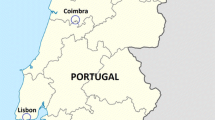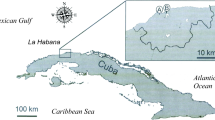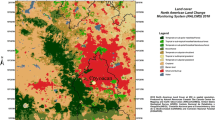Abstract
The aim of the study is to report a reliable airborne pollen spectrum composition and seasonal timings for the monitored area as a basis for allergy management and to ascertain possible modifications through the detection of trends during the 20-year time series (1989–2008). Pollen was collected at San Michele all’Adige (Trento, Italy) by means of a Hirst-type spore trap. Sampling and counting of airborne pollen grains were carried out according to a national standard. Pollen concentration data for the period were processed in order to characterize the main pollen seasons for a subset of taxa, selected on the basis of their allergenicity and local representativeness. Variations in the pollen data over the years surveyed were analyzed using non-parametric tests. The results showed the presence of 63 pollen taxa, 40 of which belonged to tree and shrub species and 23 to herbaceous species. The local pollen spectrum was characterized by the presence of highly allergenic taxa, such as Urticaceae, Graminaceae, Ostrya sp., and Cupressaceae, in terms of percentage contribution as well as mean daily pollen count or peak values over the years surveyed. A significant upward trend was observed for daily mean pollen amount, mainly due to pollen from woody species and probably ascribable to a temperature-driven increase in pollen production. Evaluation of the results presented will form the basis of further research focussed on the climate change-related causes of modifications to vegetational dynamics as well as on the phenology of flowering and on pollen production.





Similar content being viewed by others
References
Beggs, P. J. (2004). Impacts of climate change on aeroallergens: Past and future. Clinical and Experimental Allergy, 34(10), 1507–1513. doi:10.1111/j.1365-2222.2004.02061.x.
Bonofiglio, T., Orlandi, F., Sgromo, C., Romano, B., & Fornaciari, M. (2009). Evidences of olive pollination date variations in relation to spring temperature trends.Aerobiologia, 25(4), 227–237. doi:10.1007/s10453-009-9128-4.
Bucher, E., Kofler, V., Vorwohl, G., & Zieger, E. (2004). Lo spettro pollinico dei mieli dell’Alto Adige. Laives, Bolzano: Laboratorio Biologico, Agenzia Provinciale per l’Ambiente.
Compalati, E., Penagos, M., Henley, K., & Canonica, G. W. (2007). Allergy prevalence survey by the world allergy organization. Allergy & Clinical Immunology International-Journal of the World Allergy Organization, 19(3), 82–90. doi:10.1027/0838-1925.19.3.82.
D’Amato, G., Cecchi, L., Bonini, S., Nunes, C., Annesi-Maesano, I., Behrendt, H., et al. (2007). Allergenic pollen and pollen allergy in Europe. Allergy, 62, 976–990. doi:10.1111/j.1398-9995.2007.01393.x.
D’Amato, G., Liccardi, G., D’Amato, M., & Holgate, S. (2005). Environmental risk factors and allergic bronchial asthma.Clinical and Experimental Allergy, 35(9), 1113–1124. doi:10.1111/j.1365-2222.2005.02328.x.
Damialis, A., Halley, J. M., Gioulekas, D., & Vokou, D. (2007). Long-term trends in atmospheric pollen levels in the city of Thessaloniki, Greece.Atmospheric Environment, 41(33), 7011–7021. doi:10.1016/j.atmosenv.2007.05.009.
Eccel, E., & Saibanti, S. (2005). Climatic setting of the Lavarone-Vezzena Plateau in the general context of Trentino. Studi Trentini di Scienze Naturali. Acta Geologica, 82, 111–121.
Emberlin, J., Laaidi, M., Detandt, M., Gehrig, R., Jaeger, S., Myszkowska, D., et al. (2007). Climate change and evolution of the pollen content of the air in seven European countries: The example of Birch. Revue Francaise D Allergologie Et D Immunologie Clinique, 47, 57–63. doi:10.1016/j.allerg.2006.11.005.
Erbas, B., Chang, J. H., Dharmage, S., Ong, E. K., Hyndman, R., Newbigin, E., et al. (2007). Do levels of airborne grass pollen influence asthma hospital admissions?Clinical and Experimental Allergy, 37(11), 1641–1647. doi:10.1111/j.1365-2222.2007.02818.x.
Faegri, K., & Iversen, J. (1989). Textbook of pollen analysis. London: Wiley.
Favre, E., Escarguel, G., Suc, J. P., Vidal, G., & Thevenod, L. (2008). A contribution to deciphering the meaning of AP/NAP with respect to vegetation cover.Review of Palaeobotany and Palynology, 148(1), 13–35. doi:10.1016/j.revpalbo.2007.08.003.
Fornaciari, M., Pieroni, L., Ciuchi, P., & Romano, B. (1998). A regression model for the start of the pollen season in Olea europaea. Grana, 37(2), 110–113.
Frei, T. (1998). The effects of climate change in Switzerland 1969–1996 on airborne pollen quantities from hazel, birch and grass. Grana, 37(3), 172–179.
Frei, T., & Gassner, E. (2008). Climate change and its impact on birch pollen quantities and the start of the pollen season an example from Switzerland for the period 1969–2006. International Journal of Biometeorology, 52(7), 667–674. doi:10.1007/s00484-008-0159-2.
Frenz, D. A. (2000). Interpreting atmospheric pollen counts for use in clinical allergy: Spatial variability. Annals of Allergy, Asthma & Immunology, 84(5), 481–489.
Frenz, D. A. (2001). Interpreting atmospheric pollen counts for use in clinical allergy: Allergic symptomology. Annals of Allergy, Asthma & Immunology, 86(2), 150–157.
Galan, C., Garcia-Mozo, H., Vazquez, L., Ruiz, L., de la Guardia, C. D., & Trigo, M. M. (2005). Heat requirement for the onset of the Olea europaea L. pollen season in several sites in Andalusia and the effect of the expected future climate change. International Journal of Biometeorology, 49(3), 184–188. doi:10.1007/s00484-004-0223-5.
Garcia-Mozo, H., Galan, C., Belmonte, J., Bermejo, D., Candau, P., de la Guardia, C. D., et al. (2009). Predicting the start and peak dates of the Poaceae pollen season in Spain using process-based models.Agricultural and Forest Meteorology, 149(2), 256–262. doi:10.1016/j.agrformet.2008.08.013.
Gottardini, E., & Cristofolini, F. (1996). Survey of Ambrosia sp. presence by aerobiological monitoring. Colloquium Phytosociology, XXIV, 697–700.
Hollander, M., & Wolfe, D. A. (1999). Nonparametric statistical methods (2nd ed.). New York: Wiley.
IPCC. (2007). Climate change 2007—impacts, adaptation and vulnerability (Vol. 2). Cambridge: Cambridge University Press.
Jato, V., Rodriguez-Rajo, F. J., Alcazar, P., de Nuntiis, P., Galan, C., & Mandrioli, P. (2006). May the definition of pollen season influence aerobiological results?
Jato, V., Rodriguez-Rajo, F. J., Seijo, M. C., & Aira, M. J. (2009). Poaceae pollen in Galicia (NW Spain): Characterisation and recent trends in atmospheric pollen season. International Journal of Biometeorology, 53(4), 333–344. doi:10.1007/s00484-009-0220-9.
Kolmogorov, A. N. (1933). Sulla Determinazione Empirica di una Legge di Distribuzione. Giornale dell’Istituto Italiano degli Attuari, 4, 83–91.
Levetin, E., & Van de Water, P. (2008). Changing pollen types/concentrations/distribution in the United States: Fact or fiction? Current Allergy and Asthma Reports, 8(5), 418–424.
Lilliefors, H. (1967). On the Kolmogorov-Smirnov test for normality with mean and variance unknown. Journal of the American Statistical Association, 62, 399–402.
McMichael, A. J., Woodruff, R. E., & Hale, S. (2006). Climate change and human health: Present and future risks. Lancet, 367, 859–869.
Minghetti, P., & Pedrotti, F. (1999). Naturalness of vegetation of the Trentino-Alto adige region. Trento: Centro di Ecologia Alpina.
Neilson, R. P., Pitelka, L. F., Solomon, A. M., Nathan, R., Midgley, G. F., Fragoso, J. M. V., et al. (2005). Forecasting regional to global plant migration in response to climate change. BioScience, 55(9), 749–759.
Nilsson, S., & Persson, S. (1981). Tree pollen spectra in the Stockholm region Sweden 1973–1980. Grana, 20(3), 179–182.
Nilsson, S., & Praglowski, J. (1992). Erdtman’s handbook of palynology. Copenhagen: Munksgaard.
Pettitt, A. N. (1979). A non-parametric approach to the change-point problem. Applied Statistics, 28(2), 126–135.
Recio, M., Rodriguez-Rajo, F. J., Jato, M. V., Trigo, M. M., & Cabezudo, B. (2009). The effect of recent climatic trends on Urticaceae pollination in two bioclimatically different areas in the Iberian Peninsula: Malaga and Vigo. Climatic Change, 97(1–2), 215–228. doi:10.1007/s10584-009-9620-4.
Root, T. L., Price, J. T., Hall, K. R., Schneider, S. H., Rosenzweig, C., & Pounds, J. A. (2003). Fingerprints of global warming on wild animals and plants. Nature, 421(6918), 57–60. doi:10.1038/nature01333.
Sen, P. K. (1968). Estimates of the regression coefficient based on Kendall’s tau. Journal of the American Statistical Association, 63(324), 1379–1389.
Shea, K. M., Truckner, R. T., Weber, R. W., & Peden, D. B. (2008). Climate change and allergic disease. Journal of Allergy and Clinical Immunology, 122(3), 443–453. doi:10.1016/j.jaci.2008.06.032.
Spieksma, F. T. M. (1991). Regional European pollen calendars. In G. DÕAmato, F.T.M. Spieksma, & S. Bonini (Eds.), Allergenic pollen and pollinosis in Europe. Cambridge: Blackwell.
Stach, A., Smith, M., Baena, J. C. P., & Emberlin, J. (2008). Long-term and short-term forecast models for Poaceae (grass) pollen in Poznan, Poland, constructed using regression analysis. Environmental and Experimental Botany, 62(3), 323–332. doi:10.1016/j.envexpbot.2007.10.005.
Wayne, P., Foster, S., Connolly, J., Bazzaz, F., & Epstein, P. (2002). Production of allergenic pollen by ragweed (Ambrosia artemisiifolia L.) is increased in CO2-enriched atmospheres. Annals of Allergy, Asthma & Immunology, 88(3), 279–282.
Williams, R. (2005). Climate change blamed for rise in hay fever. Nature, 434(7037), 1059. doi:10.1038/nature03682.
World Health Organization. (2003). Prevention of allergy and allergic asthma. Chronic Respiratory Diseases and Arthritis 2003. Retrieved February 2, 2008, 2009, from http://www.worldallergy.org/professional/who_paa2003.pdf.
Ziska, L. H., & Caulfield, F. A. (2000). Rising CO2 and pollen production of common ragweed (Ambrosia artemisiifolia), a known allergy-inducing species: Implications for public health. Australian Journal of Plant Physiology, 27(10), 893–898.
Ziska, L. H., Epstein, P. R., & Rogers, C. A. (2008). Climate change, aerobiology, and public health in the Northeast United States. Mitigation and Adaptation Strategies for Global Change, 13(5/6), 607–613.
Acknowledgments
The Aerobiological Monitoring Centre of San Michele all’Adige was partially supported by the Environmental Protection Agency of the Autonomous Province of Trento (APPA TN). The authors are grateful to Maria Cristina Viola, whose accurate work is invaluable for the collection of high-quality environmental data.
Author information
Authors and Affiliations
Corresponding authors
Rights and permissions
About this article
Cite this article
Cristofori, A., Cristofolini, F. & Gottardini, E. Twenty years of aerobiological monitoring in Trentino (Italy): assessment and evaluation of airborne pollen variability. Aerobiologia 26, 253–261 (2010). https://doi.org/10.1007/s10453-010-9161-3
Received:
Accepted:
Published:
Issue Date:
DOI: https://doi.org/10.1007/s10453-010-9161-3




